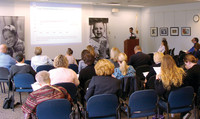Child health indicators are better in Warwick than state averages, according to the Data in Your Backyard briefing provided Warwick non-profits last Wednesday by Kids Count, in partnership with …
This item is available in full to subscribers.
We have recently launched a new and improved website. To continue reading, you will need to either log into your subscriber account, or purchase a new subscription.
If you are a current print subscriber, you can set up a free website account by clicking here.
Otherwise, click here to view your options for subscribing.
Please log in to continue |
|


Child health indicators are better in Warwick than state averages, according to the Data in Your Backyard briefing provided Warwick non-profits last Wednesday by Kids Count, in partnership with Warwick Coalition to Prevent Child Abuse. Yet, some of the numbers presented should still raise concern according to presenters.
John Neubauer, a policy analyst for Kids Count, who presented at the meeting at the Warwick Library, noted that because Warwick is one of the largest cities in the state, percentages may seem low in comparison to other municipalities, but the actual figures should still be alarming.
He said during the 2013-2014 school year 1,023 students were identified as homeless by school personnel statewide and in Warwick 74 children. Neubauer cautioned these numbers could be much higher because of the reporting system. Children who are staying with family, living in a hotel or camping out may not be reported.
Similarly, Warwick had a child poverty rate in 2014 of 8.4 percent, or nearly 1,300 children, compared to the state’s 19.5 percent. The poverty threshold for 2014 was $19,073 for a single parent family of three with two children and $24,008 for a family of four with two children. However, Neubauer pointed out that for a single parent with two children it costs at least $51,500 to meet basic needs.
“That’s twice as much as the poverty level,” he said. “More families are still struggling.”
He noted that with the country’s and Rhode Island’s slow recovery from the recession things are starting to level off.
Neubauer said part of the reason Warwick sees less childhood poverty than other communities is that mothers tend to have higher levels of education in the city, predominantly having some college or having completed an undergraduate degree. Similarly, Warwick sees fewer teenage pregnancies and births as well. Overall, teen births are declining across not only Rhode Island but nationally.
Elizabeth Burke Bryant, executive director of Kids Count, said, “Children of teen parents face a number of challenges. It is important that we ensure that teen parents are connected to the services they need to support their own health and well-being, as well as that of their child.”
Not everything at the “Data in Your Backyard” saw improvement. In comparison to the remainder of the state, especially the four core cities of Central Falls, Pawtucket, Providence and Woonsocket, Warwick lags in the implementation of full day kindergarten programs. The four core cities are at 100 percent full day K while, the state is at 81 percent and Warwick at 28 percent for 2014.
Neubauer did note though that with universal full day kindergarten being implemented next year that should resolve itself.
Although it was a very small difference, Warwick did see an increase in child abuse and neglect. In 2014, 154 children in Warwick were victims of child abuse and neglect, 9.7 victims per 1,000 children under 18. That is nearly half of the state’s rate of 14.5 victims per 1,000 children.
“Experiencing child abuse or neglect can have a damaging impact on a child’s development,” said Neubauer. “The Warwick Coalition to Prevent Child Abuse is a great example of Warwick’s commitment to keeping their children healthy and safe from harm.”
He added that with such small numbers the city shouldn’t jump to the conclusion that this will become a trend, but should “keep an eye” on it in case.
Mayor Scott Avedisian said every year Data in Your Backyard provides a great opportunity to “break down the facts and figures to better serve the children in Warwick.”
In the past, this meeting has helped establish health and dental clinics through partnerships with the Comprehensive Community Action Plan (CCAP).
Burke Bryant noted that Warwick has the “great ability” to take the information presented by Kids Count and use multi-sector solutions to see improvements.
“We need to look at what we can do to continue improving services for our families,” Avedisian said. “This data gives us the numbers to prove our points and to make our case. We have our values in the right place.”
Comments
No comments on this item Please log in to comment by clicking here